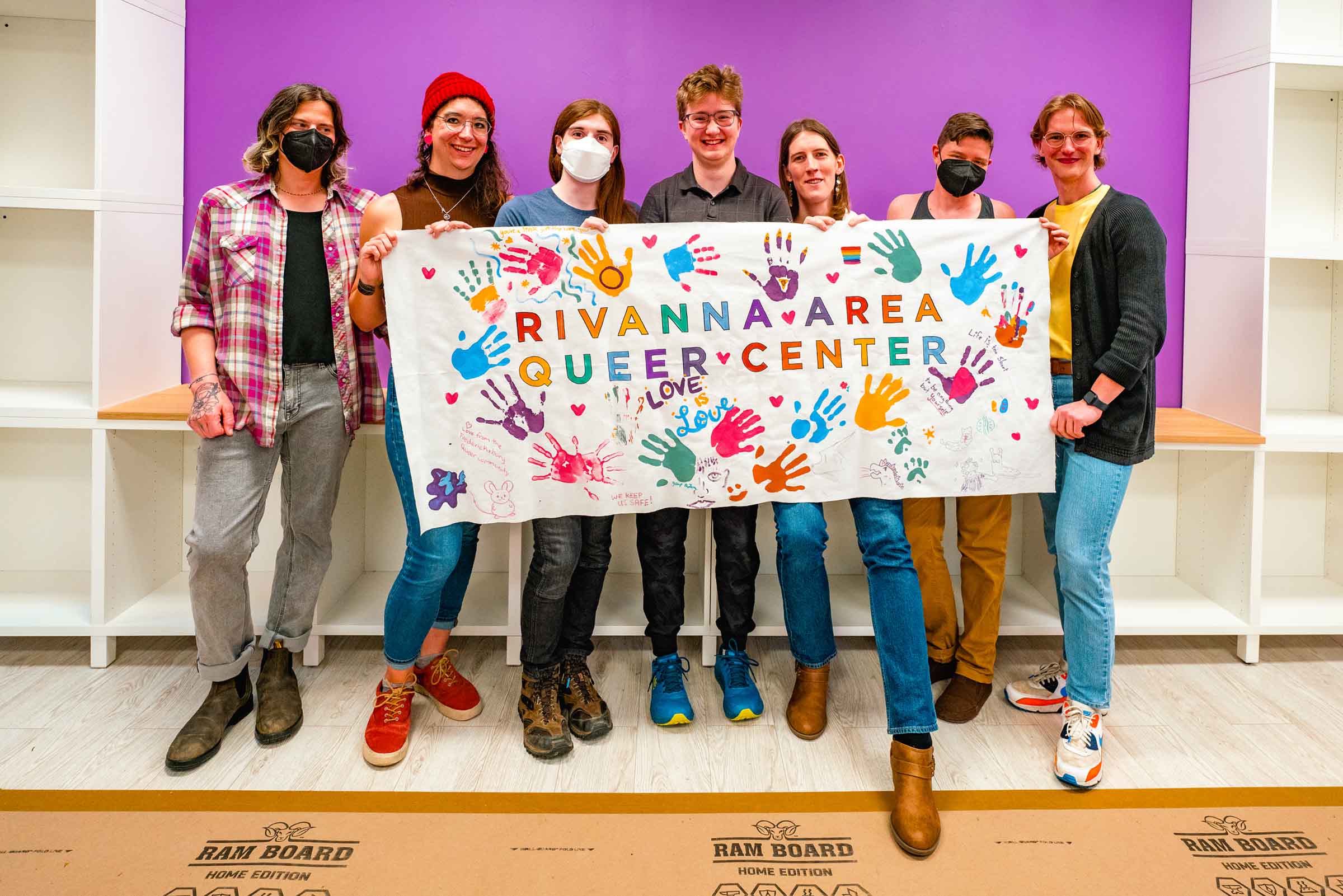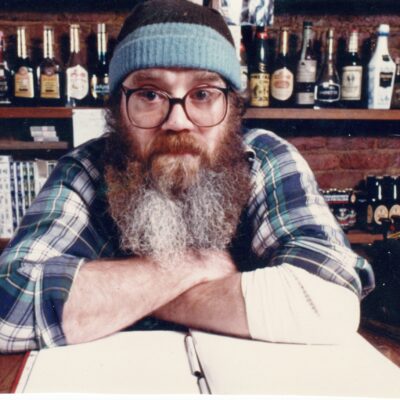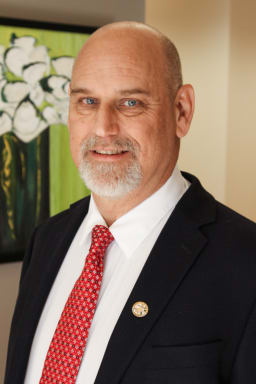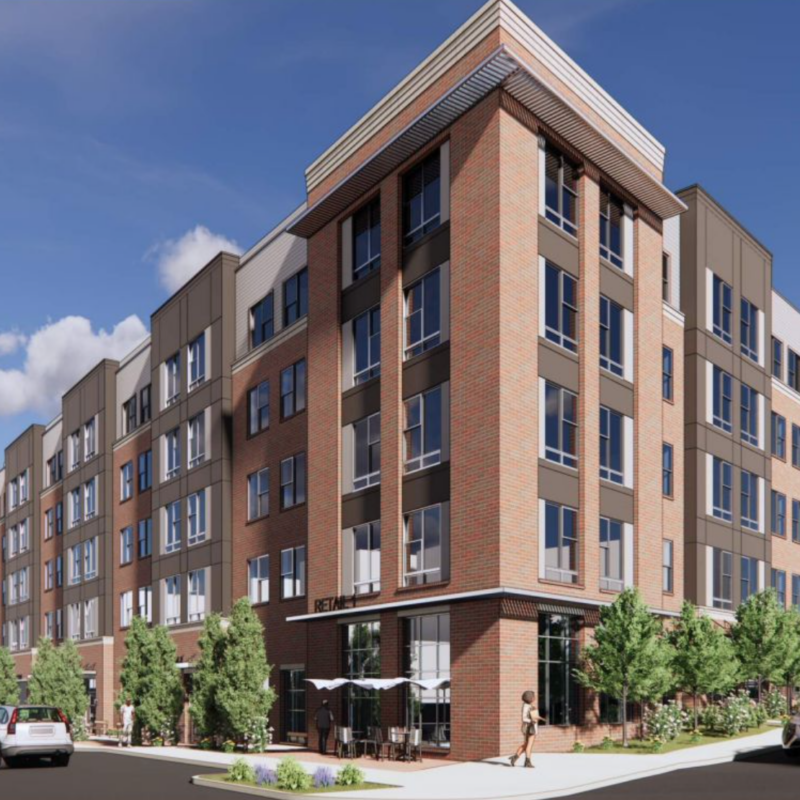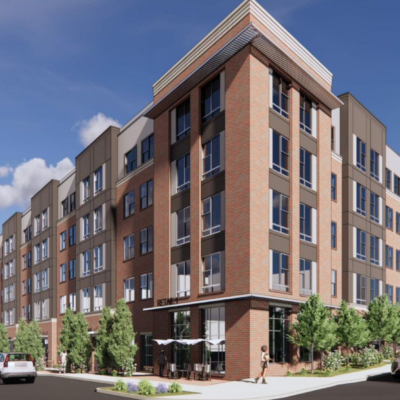The Rivanna Area Queer Center, or RAQC (pronounced “rack”), has been a months-long labor of love for area organizers. And while the LGBTQ+ community center isn’t set to open until later this spring, the space at 801 W. Main St. is quickly taking shape, entirely through the work of volunteers.
Charlottesville has a myriad of businesses owned by and friendly to the LGBTQ+ community, but dedicated, intentional spaces are few.
With the closure of the city’s last gay bar in 2020, gatherings shifted to organized events and Queer-owned/friendly businesses. Even informal community spaces have dwindled in recent years, with the shuttering of staple hangout spots like Umma’s.
Ellie Picard says that after opening Queer makers’ market The Beautiful Idea on the Downtown Mall in 2023 with Senlin Means, the need for a community center was evident.
“Since we opened our store … we’ve planned to work on a community center and thought about [it] as a long-term project,” says Picard. “Having more physical spaces in the region that are Queer owned, Queer controlled, is absolutely crucial to the vitality and sort of the survival of the community.”
RAQC became an urgent priority rather than an aspiration for Picard and other LGBTQ+ organizers after the 2024 election. The Trump administration has targeted trans and gender non-conforming people, ranging from the widescale removal of the “T” from the “LGBT” acronym on government websites to an executive order defining gender as sex assigned at birth.
“We see how fast rights and access to opportunity can be rolled back in this country, when people feel like there’s nothing stopping them from trampling on other people’s rights,” says Picard. “Having places where we can share skills, share resources, provide mutual aid to each other, and create new resources for liberation and survival—that’s desperately needed. And the act of creating those spaces does so much for our spirits, and our collective sense of hope and capability.”
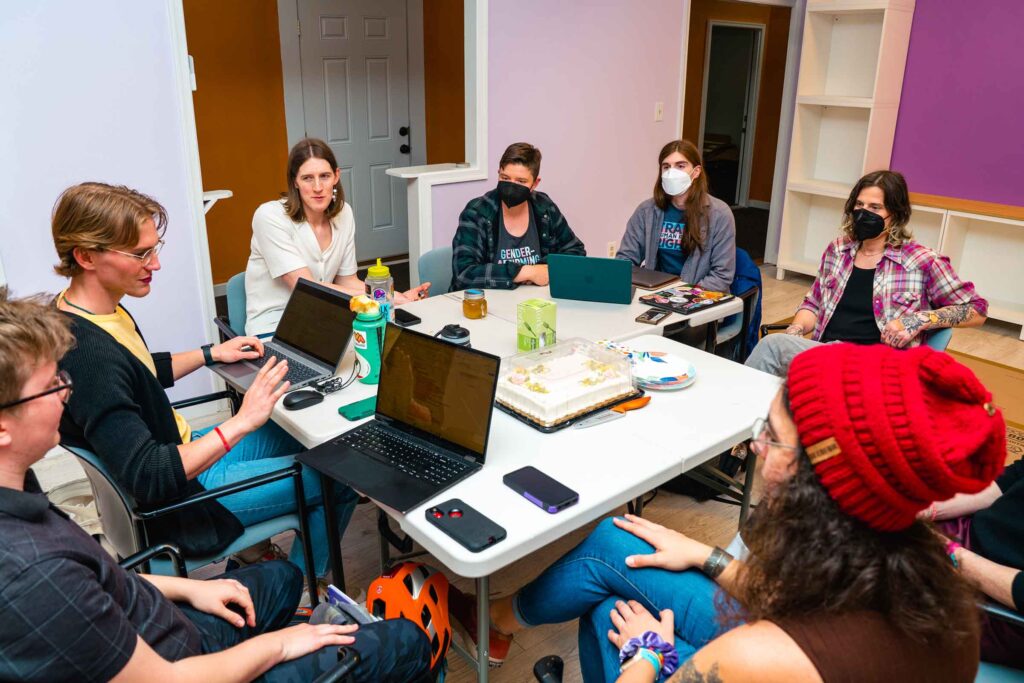
History making
The Virginian, which opened in 1923, was one of the first known accepting establishments in Charlottesville, with rumors the restaurant was “gay-friendly” tracing back to the early ’70s. Places like Brianna’s and Oasis earned similar reputations around the same time.
The ’70s also marked the emergence of LGBTQ+ history at the University of Virginia, when the Gay Student Union (now Queer Student Union) formed after an interest check for a “Gay Activist Group” was published in the Cavalier Daily in March 1972. The GSU held occasional dances at Newcomb Hall beginning in the ’70s, but did encounter pushback and hostility on Grounds, according to a 2024 article by Sarah Lindenfell Hall for UVA Magazine.
While its events were history making in their own right, the GSU didn’t have a permanent gathering place of its own, or at least not one on record. Muldowney’s Pub, opened in 1980, was Charlottesville’s first gay bar—and its first intentional, permanent LGBTQ+ space and business.
It couldn’t be advertised as a lesbian or gay bar due to ABC laws and other restrictions at the time, but Muldowney’s was an open secret, according to owner Joan Schatzman. In a 2012 interview with C-VILLE, she described the pub as “straight ’til 8,” with the small space coming alive with bands, gay comedians, DJs, and dancing at night.
When Schatzman was ready to sell the pub in 1985, the bar continued to serve as a gathering place for Charlottesville’s Queer community as The Silver Fox, run by Muldowney’s regulars Clyde Cooper, Mike Fitzgerald, Charles Ferneyhough, Ned Holt, and Ronnie Roberts.
After struggling to compete with other Queer-friendly spaces for several years, the bar became Triangles, a private, membership-based club, in 1990, then renamed and rebranded as Club 216 in 1991.
The 2010s saw the decline of gay bars nationwide, and Charlottesville was no exception. Since the closing of Club 216, Escafé, and Impulse in 2012, 2018, and 2020, respectively, more non-traditional Queer-owned and -friendly spaces emerged around the same time. Dedicated, permanent gathering places for the local LGBTQ+ community are still in short supply now, with most local LGBTQ+ gatherings more intentionally organized by groups like Out and About Charlottesville or the local PFLAG (Parents, Families, and Friends of Lesbians and Gays) chapter.
The Rivanna Area Queer Center is the start of a new chapter for the greater Charlottesville area, creating a highly visible, dedicated, and permanent space for the LGBTQ+ community.
Making space
Having a tangible space for LGBTQ+ people in Charlottesville is a big reason community members came together postelection to create RAQC.
“Physical spaces possess a gravity that media simply cannot duplicate. They provide an existential foothold from which to build our understanding of the world,” says Blake Walker, RAQC interim design committee chair. “Virtual and social connections can more readily be missed—especially if you’re new to the area.”
Organizers hope the community center, funded primarily by donations, will serve not only as a gathering place for people, but also as a place for knowledge and resources. A list of wants and needs was collated from a series of visioning sessions, including BIPOC- and disability-specific events.
“Virtually all the programming planning is directly based on feedback from the community,” says Walker. “The total list of all the community-sourced needs is too extensive to communicate here but they broadly broke down into emotional, social, and physical needs.”
From mental health counseling hours to dance classes, the possibilities for resources and events at RAQC are almost endless.
“We have designed space and amenities for local queer organizations to post information, brochures, and even store materials within RAQC for external programming needs,” says Walker. “We really want to be a resource for the entire local LGBTQIA+ community!”
Designing the space has been a massive undertaking for RAQC volunteers. Leading the effort is Walker, who is drawing on her professional experience as an architect, and input from the visioning sessions. At the top of the crowdsourced list are accessibility and adaptability. Improvements range from renovating the center’s bathroom to selecting furnishings with a range of “body types, capabilities, and capacities” in mind.
“There are all kinds of different organizations and groups that have spatial needs, that need to be together, that need to meet, that need to celebrate, things that [they] need to mourn,” says Walker. “It’s duplicating a lot of the needs that any community would have, but doing it in a space that felt safe.”
Art and opportunities for expression will also feature prominently in the RAQC’s interior.
“We’re trying to use art as a really key component of the design, so community members are directly reflected in the interior spaces,” says Walker. While there will be more curated pieces from local LGBTQ+ artists, the architect also plans to use chalkboard paint to let community members put their own mark on the space. “People can come in and write positive affirmations and literally sign the building, to kind of take ownership of it.”
Some of the artwork will also serve a functional purpose, namely window graphics to both advertise the community center and create additional privacy along the large West Main Street-facing window wall.
“My hope is that people come in and it feels cohesive and designed and nice,” says Walker. “I want people to come in and know that they’re worth it.”
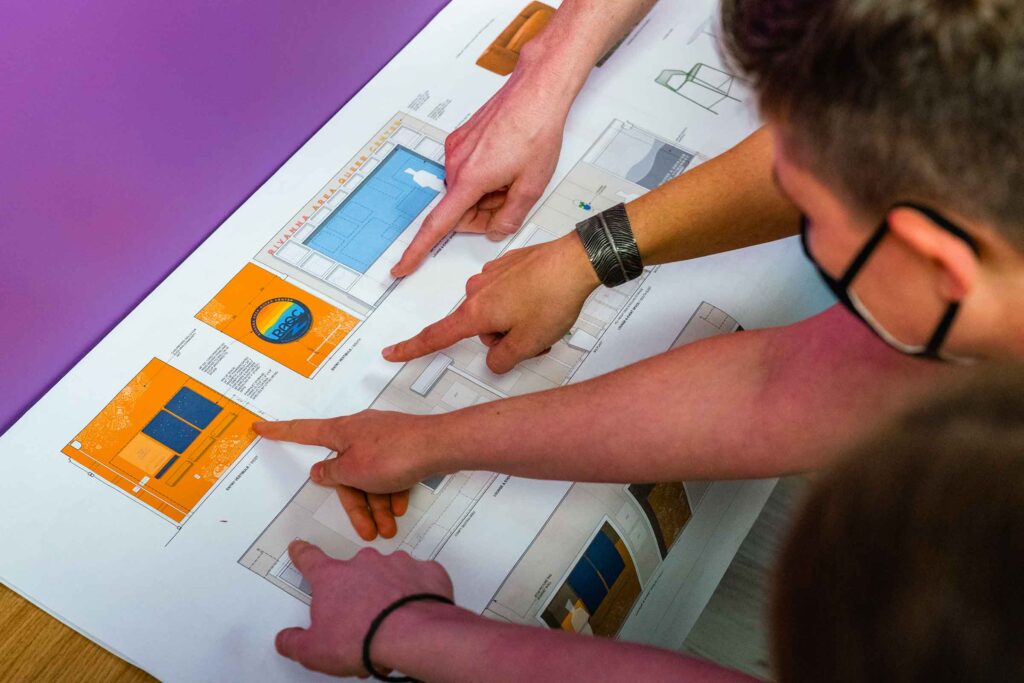
The location of the RAQC is also an intentional choice, creating a visual reminder of the local LGBTQ+ community for the entirety of Charlottesville. The address is central to downtown and the University of Virginia, and is situated along West Main, maximizing access to and eyes on the space.
“Visibility is really linked to making that constant struggle that all of us are engaged in right now apparent and visible to everybody who’s not engaged in [that] struggle,” says Walker. “Our landmarks and history are actively being erased by government mandates. It is essential we create new places we control to remain visible to the broader public.”
“The space is the mission in a lot of ways, and that’s our priority … making sure that there is a safe and accessible open space for all the Queer folks in town to use,” says Picard, who is also helping with RAQC. “There’s a lot more power in unity and cooperation and connection, and with all of the threats and the challenges that we are facing as Queer people, we need as much Queer people power as we can muster.”
A testament to that sentiment and the importance of community is Ella Jakum, RAQC financial coordinator. “I speak as the most recently transitioned member of RAQC, having begun transitioning just two months ago,” she says. “I felt comfortable to come out and renew my life in Charlottesville because I knew places like The Beautiful Idea, Visible Records, and the nascent RAQC were here. I knew there were spaces where incredible Queer people were congregating to strengthen our community and build our culture. I felt safe in Charlottesville for their visibility and now I am out and happier than ever.“
Past and future
For now, RAQC is a work in progress.
“At the end of the day, we’re going to fail in some capacity, we can’t meet everybody’s needs. People are going to have opinions about what we’re doing and are going to say that we did it the wrong way, or that it could have been better, and in some instances, they’re totally gonna be right,” says Walker. “But … we’re doing the best we can. We’re really trying … to really meet the needs of as many people in the community as possible.”
There’s still a lot to do, and the late-May opening timeline could get pushed back. But the next page in Charlottesville’s Queer history is on the horizon.
“I think history is a really important part of identity. … Not only are we creating RAQC as a place to define who we are now, but I also hope … we can use it as a place to aggregate a shared history, and it can give us a greater sense of permanence and continuity than the nothing that we have right now—or the history that some of us have in our heads of places like Escafé or Club 216,” says Walker. “That memory lives in me. But younger folks … have no connection to that, no sense of what it is. I think having that history in a visual way that people can understand that they’re part of a lineage, I think it’s really, really important.”
Photos: Tristan Williams
